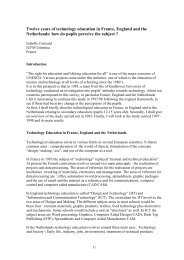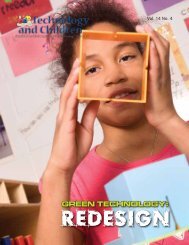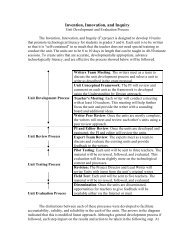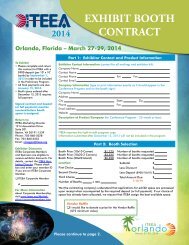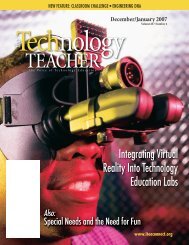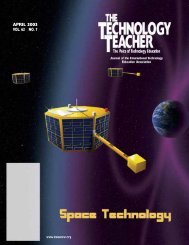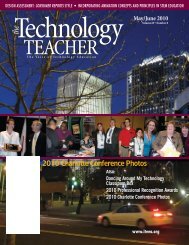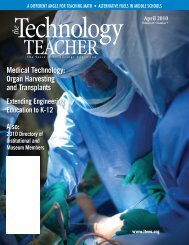May/June 2009 - International Technology and Engineering ...
May/June 2009 - International Technology and Engineering ...
May/June 2009 - International Technology and Engineering ...
Create successful ePaper yourself
Turn your PDF publications into a flip-book with our unique Google optimized e-Paper software.
justification for the rest of the initial choices that were not<br />
selected. Once the best design is identified, students will<br />
determine the different components that comprise a UROV<br />
<strong>and</strong> assign each category to smaller groups within the class.<br />
Such components include the fabrication of the exoskeleton,<br />
propulsion of the vehicle, communication systems, <strong>and</strong><br />
navigation.<br />
Each group will now work independently, <strong>and</strong> the instructor<br />
will serve as a moderator to ensure that all groups are on the<br />
same task. As groups complete their tasks, the instructor<br />
will evaluate their work <strong>and</strong> ensure that components will<br />
fit well in order for the vehicle to be functional. During<br />
the building process, even though each group works<br />
independently, weekly progress reports will be given to<br />
the rest of the groups, <strong>and</strong> a problem-solving session<br />
will take place for groups to help each other. Also, a daily<br />
journal should be kept by each group. Once the project is<br />
complete, the journals can be combined <strong>and</strong> shared. During<br />
construction of the UROV, students will apply physics <strong>and</strong><br />
math skills that relate to buoyancy <strong>and</strong> resistance of the<br />
vehicle underwater, biology in the way a UROV can affect<br />
the environment, engineering concepts by calculating<br />
hydrodynamics <strong>and</strong> material properties, <strong>and</strong>, of course,<br />
technology education principles through the entire vehicle<br />
fabrication process.<br />
Activities such as the one described above are easy to<br />
correlate with St<strong>and</strong>ards for Technological Literacy: Content<br />
for the Study of <strong>Technology</strong>, (ITEA, 2000/2002/2007). See<br />
Table 1 for correlations with ITEA’s st<strong>and</strong>ards.<br />
Summary<br />
Throughout history the oceans have directly or indirectly<br />
influenced humans. The importance of knowing how<br />
to protect this valuable resource <strong>and</strong> insure it for future<br />
generations is vital. Underwater Vehicles are tools essential<br />
for this process, <strong>and</strong> therefore research <strong>and</strong> development<br />
to perfect these devices is needed. However, the main goal<br />
of these devices—to transmit images from places where<br />
humans cannot go—remains the same, <strong>and</strong> their importance<br />
to future discoveries remains vital.<br />
ITEA. (1996). <strong>Technology</strong> for all Americans: A rationale <strong>and</strong><br />
structure for the study of technology. Reston, VA: Author.<br />
ITEA. (2000/2002/2007). St<strong>and</strong>ards for technological<br />
literacy: Content for the Study of <strong>Technology</strong>. Reston, VA:<br />
Author.<br />
MacFarlane, J. & Petters, D. (1986). Submersibles in<br />
Underwater Mining. <strong>Engineering</strong> Digest.<br />
Mahesh, H. & Yuh, J. (1991). A Coordinated Control of an<br />
Underwater Vehicle <strong>and</strong> Robotic Manipulator. Journal of<br />
Robotic Systems, 8(3), 339-370.<br />
McMillan, B. & Musick, J. (2007). Oceans. Sydney, Australia:<br />
Weldon Owen, Inc.<br />
Massachusetts Institute of <strong>Technology</strong>. (2006). AUV history.<br />
Retrieved March 3, <strong>2009</strong>, from http://auvlab.mit.edu.<br />
Narayan, G. S. (1986). Feasibility study of jet propulsion<br />
for remote operated underwater vehicles. M.Eng.<br />
dissertation, Memorial University of Newfoundl<strong>and</strong>,<br />
Canada. Retrieved February 24, <strong>2009</strong>, from Dissertations<br />
& Theses: Full Text database. (Publication No. AAT<br />
ML33611).<br />
Mahdi, H. (2000). Underwater vehicles: Is the challenge<br />
technological, economic, HSE, or quality? Proceedings:<br />
UUVS 2000, Southampton, UK.<br />
Ramaswamy, H. (2002). Design of a tetherless remotely<br />
operated underwater vehicle. M.A.Sc. dissertation,<br />
University of Victoria, Canada. Retrieved February 24,<br />
<strong>2009</strong>, from Dissertations & Theses: Full Text database.<br />
(Publication No. AAT MQ74971).<br />
Welsh, R. (2000). Proceedings from the <strong>International</strong><br />
Unmanned Undersea Vehicle Symposium. Advances in<br />
efficient submersible acoustic mobile networks. Newport,<br />
RI.<br />
Petros J. Katsioloudis, PhD is an assistant<br />
professor <strong>and</strong> Ambassador to Cyprus for<br />
the <strong>International</strong> <strong>Technology</strong> Education<br />
Association. He is a member of the<br />
Department of Occupational <strong>and</strong> Technical<br />
Studies at Old Dominion University in<br />
Norfolk, Virginia.<br />
References<br />
Comms, P. (1999). High data rate acoustic communications<br />
for doubly spread underwater acoustic channels. Europe:<br />
Undersea Defense <strong>Technology</strong>.<br />
Drew, M. (2006). ROV educational materials. Retrieved<br />
March 3, <strong>2009</strong>, from www.rov.org/education.html.<br />
16 • The <strong>Technology</strong> Teacher • <strong>May</strong>/<strong>June</strong> <strong>2009</strong>



